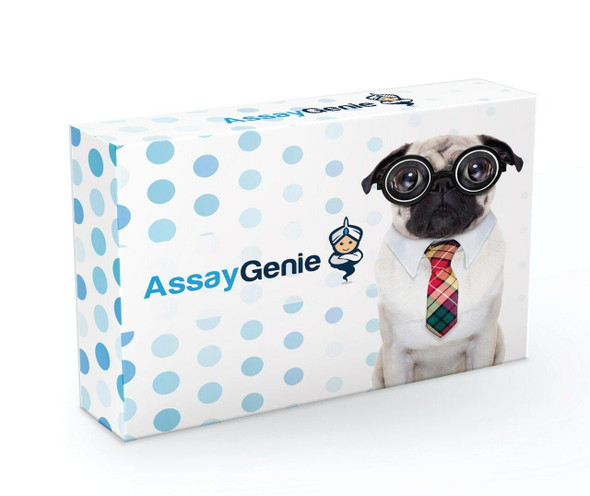Description
Human CD40 ligand (CD40LG) ELISA Kit
The Human CD40 Ligand (CD40LG) ELISA Kit is specifically designed for the sensitive and accurate detection of CD40 Ligand levels in human serum, plasma, and cell culture supernatants. This kit is ideal for researchers studying immune responses, inflammation, and autoimmune diseases.CD40 Ligand is a critical protein involved in the activation of immune cells and the regulation of the immune response. Dysregulation of CD40 Ligand has been associated with various autoimmune disorders, making it an important biomarker for understanding the underlying mechanisms of these conditions.
With its high sensitivity and specificity, the Human CD40 Ligand ELISA Kit provides reliable and reproducible results, allowing for precise measurement of CD40 Ligand levels in biological samples. This kit is a valuable tool for researchers looking to further explore the role of CD40 Ligand in immune-related diseases and potential therapeutic interventions.
| Product Name: | Human CD40 ligand (CD40LG) ELISA Kit |
| SKU: | HUEB0145 |
| Size: | 96T |
| Target: | Human CD40 ligand (CD40LG) |
| Synonyms: | T-cell antigen Gp39, TNF-related activation protein, Tumor necrosis factor ligand superfamily member 5, TRAP, CD154, CD40-L, CD40L, TNFSF5, TRAP |
| Assay Type: | Sandwich |
| Detection Method: | ELISA |
| Reactivity: | Human |
| Detection Range: | 0.156-10ng/mL |
| Sensitivity: | 0.032ng/mL |
| Intra CV: | 5.3% | ||||||||||||||||||||
| Inter CV: | 9.8% | ||||||||||||||||||||
| Linearity: |
| ||||||||||||||||||||
| Recovery: |
| ||||||||||||||||||||
| Function: | Release of soluble CD40L from platelets is partially regulated by GP IIb/IIIa, actin polymerization, and an matrix metalloproteinases (MMP) inhibitor-sensitive pathway. |
| Uniprot: | P29965 |
| Sample Type: | Serum, plasma, tissue homogenates, cell culture supernates and other biological fluids |
| Specificity: | Natural and recombinant human CD40 ligand |
| Sub Unit: | Homotrimer (PubMed:8589998, PubMed:8626375, PubMed:11676606). Interacts with isoform 3 of CD28 (PubMed:15067037). |
| Research Area: | Immunology |
| Subcellular Location: | CD40 ligand, soluble form Secreted |
| Storage: | Please see kit components below for exact storage details |
| Note: | For research use only |
| UniProt Protein Function: | CD40LG: Mediates B-cell proliferation in the absence of co- stimulus as well as IgE production in the presence of IL-4. Involved in immunoglobulin class switching. Defects in CD40LG are the cause of X-linked immunodeficiency with hyper-IgM type 1 (HIGM1); also known as X-linked hyper IgM syndrome (XHIM). HIGM1 is an immunoglobulin isotype switch defect characterized by elevated concentrations of serum IgM and decreased amounts of all other isotypes. Affected males present at an early age (usually within the first year of life) recurrent bacterial and opportunistic infections, including Pneumocystis carinii pneumonia and intractable diarrhea due to cryptosporidium infection. Despite substitution treatment with intravenous immunoglobulin, the overall prognosis is rather poor, with a death rate of about 10% before adolescence. Belongs to the tumor necrosis factor family. |
| UniProt Protein Details: | Protein type:Membrane protein, integral; Cell adhesion Chromosomal Location of Human Ortholog: Xq26 Cellular Component: extracellular space; integral to plasma membrane; integral to membrane; plasma membrane; external side of plasma membrane Molecular Function:CD40 receptor binding; cytokine activity; tumor necrosis factor receptor binding Biological Process: B cell proliferation; platelet activation; regulation of immune response; leukocyte adhesion; positive regulation of interleukin-12 production; B cell differentiation; immunoglobulin secretion; isotype switching; inflammatory response; regulation of immunoglobulin secretion; negative regulation of apoptosis Disease: Immunodeficiency With Hyper-igm, Type 1 |
| NCBI Summary: | The protein encoded by this gene is expressed on the surface of T cells. It regulates B cell function by engaging CD40 on the B cell surface. A defect in this gene results in an inability to undergo immunoglobulin class switch and is associated with hyper-IgM syndrome. [provided by RefSeq, Jul 2008] |
| UniProt Code: | P29965 |
| NCBI GenInfo Identifier: | 231718 |
| NCBI Gene ID: | 959 |
| NCBI Accession: | P29965.1 |
| UniProt Related Accession: | P29965 |
| Molecular Weight: | 29,274 Da |
| NCBI Full Name: | CD40 ligand |
| NCBI Synonym Full Names: | CD40 ligand |
| NCBI Official Symbol: | CD40LG |
| NCBI Official Synonym Symbols: | IGM; IMD3; TRAP; gp39; CD154; CD40L; HIGM1; T-BAM; TNFSF5; hCD40L |
| NCBI Protein Information: | CD40 ligand; CD40-L; CD40 antigen ligand; T-cell antigen Gp39; T-B cell-activating molecule; TNF-related activation protein; tumor necrosis factor (ligand) superfamily member 5 |
| UniProt Protein Name: | CD40 ligand |
| UniProt Synonym Protein Names: | T-cell antigen Gp39; TNF-related activation protein; TRAP; Tumor necrosis factor ligand superfamily member 5; CD_antigen: CD154Cleaved into the following 2 chains:CD40 ligand, membrane form; CD40 ligand, soluble form |
| UniProt Gene Name: | CD40LG |
| UniProt Entry Name: | CD40L_HUMAN |
| Component | Quantity (96 Assays) | Storage |
| ELISA Microplate (Dismountable) | 8×12 strips | -20°C |
| Lyophilized Standard | 2 | -20°C |
| Sample Diluent | 20ml | -20°C |
| Assay Diluent A | 10mL | -20°C |
| Assay Diluent B | 10mL | -20°C |
| Detection Reagent A | 120µL | -20°C |
| Detection Reagent B | 120µL | -20°C |
| Wash Buffer | 30mL | 4°C |
| Substrate | 10mL | 4°C |
| Stop Solution | 10mL | 4°C |
| Plate Sealer | 5 | - |
Other materials and equipment required:
- Microplate reader with 450 nm wavelength filter
- Multichannel Pipette, Pipette, microcentrifuge tubes and disposable pipette tips
- Incubator
- Deionized or distilled water
- Absorbent paper
- Buffer resevoir
*Note: The below protocol is a sample protocol. Protocols are specific to each batch/lot. For the correct instructions please follow the protocol included in your kit.
Allow all reagents to reach room temperature (Please do not dissolve the reagents at 37°C directly). All the reagents should be mixed thoroughly by gently swirling before pipetting. Avoid foaming. Keep appropriate numbers of strips for 1 experiment and remove extra strips from microtiter plate. Removed strips should be resealed and stored at -20°C until the kits expiry date. Prepare all reagents, working standards and samples as directed in the previous sections. Please predict the concentration before assaying. If values for these are not within the range of the standard curve, users must determine the optimal sample dilutions for their experiments. We recommend running all samples in duplicate.
| Step | |
| 1. | Add Sample: Add 100µL of Standard, Blank, or Sample per well. The blank well is added with Sample diluent. Solutions are added to the bottom of micro ELISA plate well, avoid inside wall touching and foaming as possible. Mix it gently. Cover the plate with sealer we provided. Incubate for 120 minutes at 37°C. |
| 2. | Remove the liquid from each well, don't wash. Add 100µL of Detection Reagent A working solution to each well. Cover with the Plate sealer. Gently tap the plate to ensure thorough mixing. Incubate for 1 hour at 37°C. Note: if Detection Reagent A appears cloudy warm to room temperature until solution is uniform. |
| 3. | Aspirate each well and wash, repeating the process three times. Wash by filling each well with Wash Buffer (approximately 400µL) (a squirt bottle, multi-channel pipette,manifold dispenser or automated washer are needed). Complete removal of liquid at each step is essential. After the last wash, completely remove remaining Wash Buffer by aspirating or decanting. Invert the plate and pat it against thick clean absorbent paper. |
| 4. | Add 100µL of Detection Reagent B working solution to each well. Cover with the Plate sealer. Incubate for 60 minutes at 37°C. |
| 5. | Repeat the wash process for five times as conducted in step 3. |
| 6. | Add 90µL of Substrate Solution to each well. Cover with a new Plate sealer and incubate for 10-20 minutes at 37°C. Protect the plate from light. The reaction time can be shortened or extended according to the actual color change, but this should not exceed more than 30 minutes. When apparent gradient appears in standard wells, user should terminatethe reaction. |
| 7. | Add 50µL of Stop Solution to each well. If color change does not appear uniform, gently tap the plate to ensure thorough mixing. |
| 8. | Determine the optical density (OD value) of each well at once, using a micro-plate reader set to 450 nm. User should open the micro-plate reader in advance, preheat the instrument, and set the testing parameters. |
| 9. | After experiment, store all reagents according to the specified storage temperature respectively until their expiry. |
When carrying out an ELISA assay it is important to prepare your samples in order to achieve the best possible results. Below we have a list of procedures for the preparation of samples for different sample types.
| Sample Type | Protocol |
| Serum | If using serum separator tubes, allow samples to clot for 30 minutes at room temperature. Centrifuge for 10 minutes at 1,000x g. Collect the serum fraction and assay promptly or aliquot and store the samples at -80°C. Avoid multiple freeze-thaw cycles. If serum separator tubes are not being used, allow samples to clot overnight at 2-8°C. Centrifuge for 10 minutes at 1,000x g. Remove serum and assay promptly or aliquot and store the samples at -80°C. Avoid multiple freeze-thaw cycles. |
| Plasma | Collect plasma using EDTA or heparin as an anticoagulant. Centrifuge samples at 4°C for 15 mins at 1000 × g within 30 mins of collection. Collect the plasma fraction and assay promptly or aliquot and store the samples at -80°C. Avoid multiple freeze-thaw cycles. Note: Over haemolysed samples are not suitable for use with this kit. |
| Urine & Cerebrospinal Fluid | Collect the urine (mid-stream) in a sterile container, centrifuge for 20 mins at 2000-3000 rpm. Remove supernatant and assay immediately. If any precipitation is detected, repeat the centrifugation step. A similar protocol can be used for cerebrospinal fluid. |
| Cell culture supernatant | Collect the cell culture media by pipette, followed by centrifugation at 4°C for 20 mins at 1500 rpm. Collect the clear supernatant and assay immediately. |
| Cell lysates | Solubilize cells in lysis buffer and allow to sit on ice for 30 minutes. Centrifuge tubes at 14,000 x g for 5 minutes to remove insoluble material. Aliquot the supernatant into a new tube and discard the remaining whole cell extract. Quantify total protein concentration using a total protein assay. Assay immediately or aliquot and store at ≤ -20 °C. |
| Tissue homogenates | The preparation of tissue homogenates will vary depending upon tissue type. Rinse tissue with 1X PBS to remove excess blood & homogenize in 20ml of 1X PBS (including protease inhibitors) and store overnight at ≤ -20°C. Two freeze-thaw cycles are required to break the cell membranes. To further disrupt the cell membranes you can sonicate the samples. Centrifuge homogenates for 5 mins at 5000xg. Remove the supernatant and assay immediately or aliquot and store at -20°C or -80°C. |
| Tissue lysates | Rinse tissue with PBS, cut into 1-2 mm pieces, and homogenize with a tissue homogenizer in PBS. Add an equal volume of RIPA buffer containing protease inhibitors and lyse tissues at room temperature for 30 minutes with gentle agitation. Centrifuge to remove debris. Quantify total protein concentration using a total protein assay. Assay immediately or aliquot and store at ≤ -20 °C. |
| Breast Milk | Collect milk samples and centrifuge at 10,000 x g for 60 min at 4°C. Aliquot the supernatant and assay. For long term use, store samples at -80°C. Minimize freeze/thaw cycles. |










